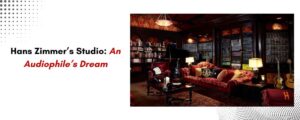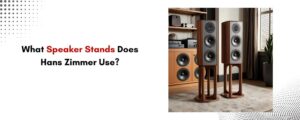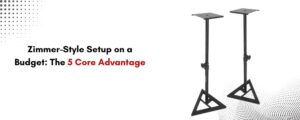When you think of epic soundtracks, chances are Hans Zimmer‘s name comes to mind. From Inception to The Dark Knight to Dune, Zimmer’s orchestral mastery doesn’t just rely on talent—it’s also about the gear that surrounds him. In the world of sound design, even the smallest accessory—like the right speaker stand—can make a monumental difference.
So, what stands does Hans Zimmer use in his studio, and how can audiophiles, sound engineers, or aspiring composers benefit from similar tools?
Let’s break it down.
Hans Zimmer’s Studio: An Audiophile’s Dream
Hans Zimmer’s studio, located in Santa Monica, California, is more than just a workspace—it’s a sound sanctuary. Known as Remote Control Productions, this musical fortress is loaded with rare instruments, top-of-the-line analog gear, and precision speaker systems. His studio is treated acoustically for perfect sound dispersion, and each speaker element is carefully mounted, often on custom or premium-grade speaker stands.
Zimmer’s setup includes midfield and nearfield monitors, supported by heavy-duty adjustable stands that isolate vibration, preserve sound imaging, and allow for precise monitor placement—critical for mixing cinematic scores.
While Zimmer may use custom stands built for ultra-premium gear, there are studio monitor stands available to the public that offer similar benefits for a fraction of the cost.
A Deeper Look Inside Hans Zimmer’s Legendary Studio
Hans Zimmer’s studio—Remote Control Productions (RCP)—is unlike any other production space in the music industry. Located in Santa Monica, California, it’s part studio, part creative think tank, and part musical museum.
This is where soundtracks for Gladiator, Interstellar, Pirates of the Caribbean, Dune, and dozens of other iconic films were born.
Zimmer’s creative sanctuary is packed with:
- Dozens of analog and digital synthesizers
- A Bösendorfer piano that’s been modified with MIDI capabilities
- Vintage outboard gear and mixing desks
- State-of-the-art studio monitors from companies like PMC, Genelec, and ADAM Audio
But amidst all the glamor, there’s one constant—precision speaker placement, which is supported by heavy-duty speaker stands engineered to eliminate sound coloration and reflect true audio imaging.
What Speaker Stands Does Hans Zimmer Use?
While Hans Zimmer has never publicly endorsed a specific commercial speaker stand brand, through interviews, studio walkthroughs (like the one from Spitfire Audio), and high-resolution studio photography, you can spot robust, telescoping speaker stands with wide triangular bases.
These stands are built to:
- Hold high-end, heavy studio monitors
- Eliminate vibrations and resonance
- Position speakers perfectly in relation to the listener’s ears
- Withstand daily wear and movement during different mixes
Zimmer’s studio also includes custom-built isolating floor stands—many of which are similar in structure to tripod speaker stands used in professional broadcast and live sound environments.
In essence, he opts for modular, height-adjustable stands with isolation capabilities, similar in function to those found in 5 Core’s high-quality speaker stand collection.
The Zimmer Sound: Why Stands Matter in His Workflow
Zimmer’s sound is characterized by depth, cinematic scope, and frequency layering. To achieve this, he relies on a multi-monitor setup, often with nearfield monitors for detail work and midfield monitors for immersive layering.
All of these speakers require precise axial alignment and isolation—which is impossible if the monitors are sitting directly on a desk or shelf.
That’s where the speaker stands come in. They serve three essential functions in his studio:
1. Speaker Positioning for Phase Coherence
Hans aligns his monitors in such a way that the tweeters hit ear-level when seated. The angle and height of the monitors are adjusted using telescoping stands to minimize phase distortion—a common issue when left and right channels aren’t aligned.
2. Eliminating Unwanted Vibrations
Massive subwoofers and monitor arrays can shake walls and racks. By isolating each speaker using a stand with a stable triangle base, Zimmer ensures clean signal delivery and reduces harmonic distortion from surface vibration.
3. Ergonomics and Flexibility
Zimmer’s workflow demands movement—from analog synths to DAWs to scoring desks. His stands let him reposition speakers depending on the session, whether he’s mixing action-heavy scenes or emotional piano melodies.
These same principles are mirrored in stands like the 5 Core Tripod Speaker Stand, which also:
- Adjust from 35” to 55” height
- Use a three-point triangle base for maximum stability
- Support studio monitors, bookshelf speakers, PA gear, and more
These are the very types of stands that mirror Zimmer’s audio philosophy: no compromise on sound integrity.
Zimmer-Style Setup on a Budget: The 5 Core Advantage
You don’t need Zimmer’s million-dollar studio to benefit from his techniques. The 5 Core tripod speaker stand brings professional performance to bedroom producers, podcasters, DJs, and home studio enthusiasts.
Why 5 Core’s Speaker Stands Deliver Zimmer-Level Benefits:
| Feature | Zimmer’s Studio | 5 Core Speaker Stand |
| Telescoping Height | ✅ | ✅ (35”–55”) |
| Triangle Base Stability | ✅ | ✅ |
| Vibration Isolation | ✅ | ✅ (Steel frame + rubber feet) |
| Monitor Compatibility | ✅ (Custom) | ✅ (Universal) |
| Professional Sound Imaging | ✅ | ✅ |
Zimmer’s Philosophy: Sound First, Always
Zimmer once said,
“It’s not just about hearing a note. It’s about feeling it—viscerally, emotionally, physically.”
To achieve this, every detail in his studio—down to the angle of a speaker—is optimized for sonic purity. Stands might be overlooked by newcomers, but in his world, they’re essential tools.
If you want to experience even 10% of what Zimmer hears in his space, start by lifting your monitors off your desk and placing them on a solid, vibration-dampening, adjustable stand.
The 5 Core tripod speaker stand is an excellent place to begin.
Conclusion
Hans Zimmer’s legendary studio isn’t just a feast for the eyes—it’s a testament to the idea that great sound needs a solid foundation. And that starts with stands built to precision.
While you may not own a wall of Moogs or a rare modular rig from the ’70s, you can still embrace the same philosophy that powers Oscar-winning soundtracks: clarity, accuracy, and intention.
Start with the fundamentals. Start with your speaker placement. Start with a high-quality stand.
Upgrade Like Zimmer – Shop Now
Bring your speakers to life with the same design approach used by Hollywood’s finest.
Shop 5 Core’s Tripod Speaker Stand today and hear the difference.




